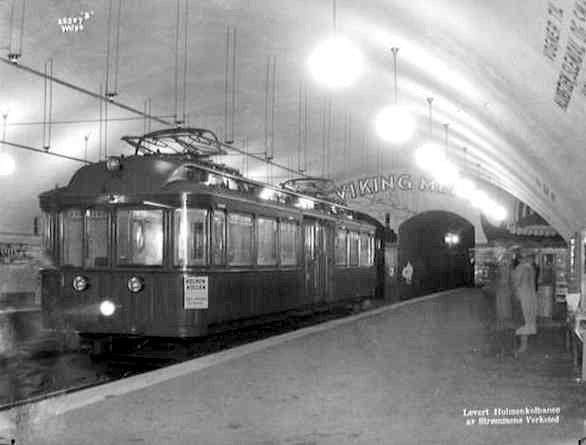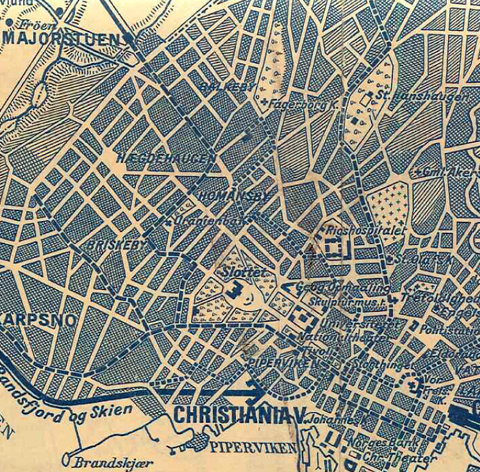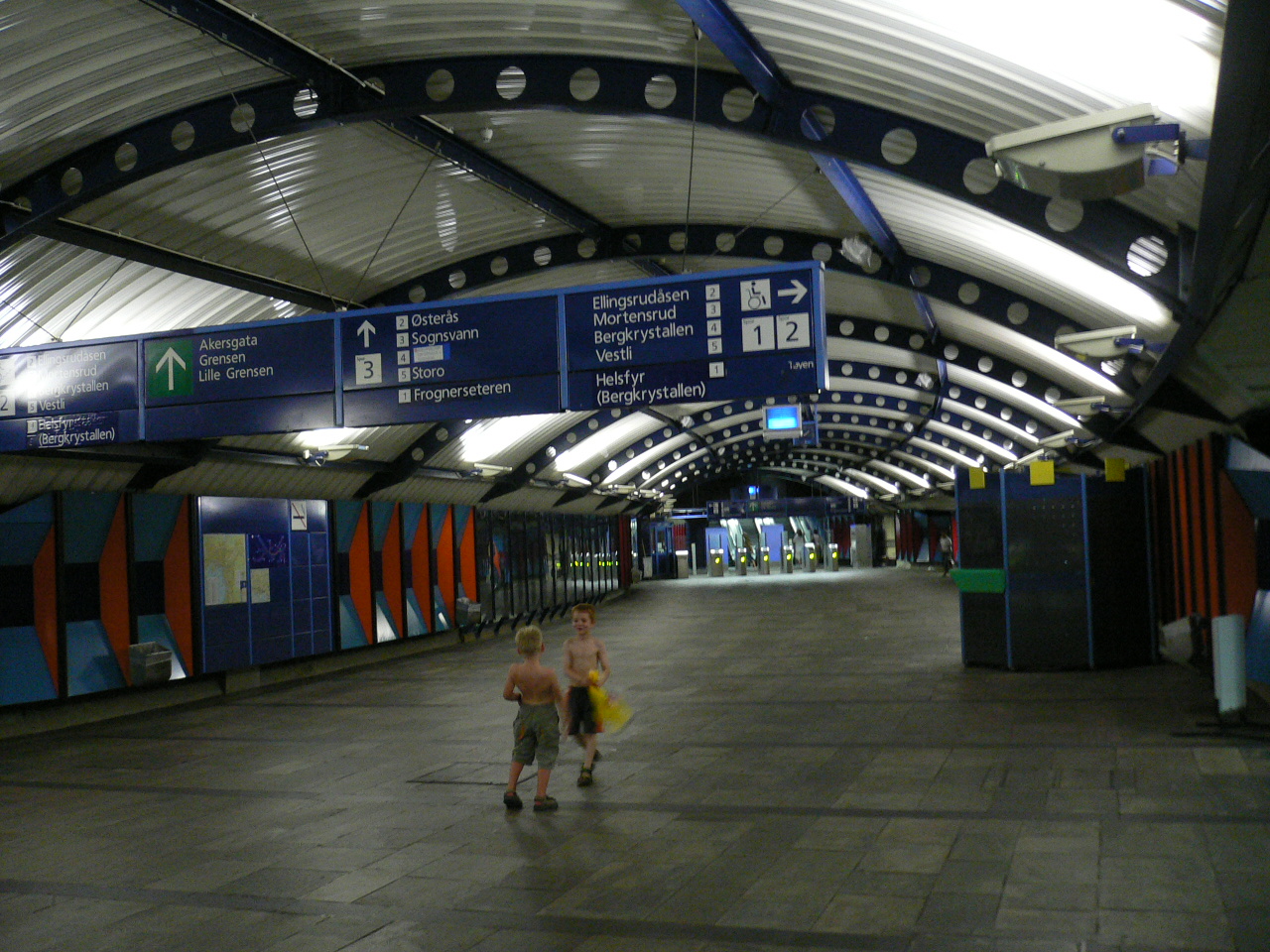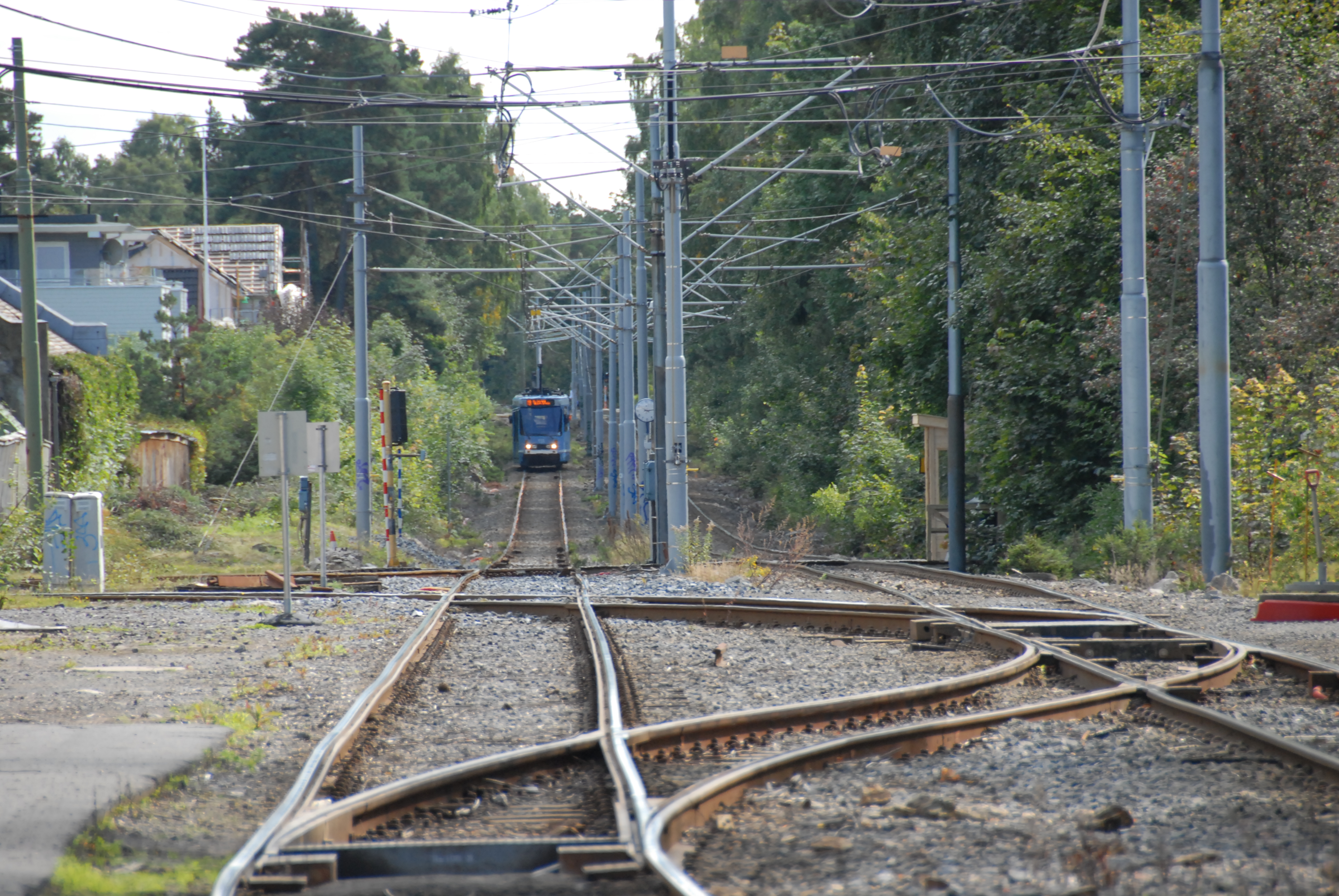|
Jernbanetorget
Jernbanetorget or Jernbanetorvet is both a rapid transit station on the Oslo Metro and a tram stop of the Oslo Tramway. The metro station is in the Common Tunnel used by all lines under the city centre. It is located between Stortinget (station), Stortinget to the west and Grønland (station), Grønland to the east. Until the construction of the station at Stortinget, Jernbanetorget was the end station for the eastern lines in downtown. Along with the Oslo Central Station, Oslo Bus Terminal and the Oslo Tramway, tram and bus station above ground, Jernbanetorget is the largest transport hub in Norway. All six of the subway lines (including the Ring Route - which is a part of Line 5) pass through the station, totaling 24 departures per hour during most of the day. The station is from Stortinget and submerged below sea level. It is also the central hub of the tram network with five of the six lines using either the platform in front of Christiania Hotel or the one in front of the ... [...More Info...] [...Related Items...] OR: [Wikipedia] [Google] [Baidu] |
Oslo Metro
The Oslo Metro ( or or simply ) is the rapid transit system of Oslo, Norway, operated by Sporveien T-banen on contract from the transit authority Ruter. The network consists of five lines that all run through the city centre, with a total length of , serving 101 stations of which 17 are underground or indoors. In addition to serving 14 out of the 15 boroughs of Oslo, two lines run to Kolsås and Østerås, in the neighbouring municipality of Bærum. In 2016, the system had an annual ridership of 118 million. The first rapid transit line, the Holmenkollen Line, opened in 1898, with the branch Røa Line opening in 1912. It became the first Nordic underground rapid transit system in 1928, when the underground line to Nationaltheatret was opened. After 1993 trains ran under the city between the eastern and western networks in the Common Tunnel, followed by the 2006 opening of the Ring Line. All the trains are operated with MX3000 stock. These replaced the older T1000 stock ... [...More Info...] [...Related Items...] OR: [Wikipedia] [Google] [Baidu] |
Jernbanetorget 1938 OB
Jernbanetorget or Jernbanetorvet is both a rapid transit station on the Oslo Metro and a tram stop of the Oslo Tramway. The metro station is in the Common Tunnel used by all lines under the city centre. It is located between Stortinget to the west and Grønland to the east. Until the construction of the station at Stortinget, Jernbanetorget was the end station for the eastern lines in downtown. Along with the Oslo Central Station, Oslo Bus Terminal and the tram and bus station above ground, Jernbanetorget is the largest transport hub in Norway. All six of the subway lines (including the Ring Route - which is a part of Line 5) pass through the station, totaling 24 departures per hour during most of the day. The station is from Stortinget and submerged below sea level. It is also the central hub of the tram network with five of the six lines using either the platform in front of Christiania Hotel or the one in front of the public transport information centre, Trafikanten. Th ... [...More Info...] [...Related Items...] OR: [Wikipedia] [Google] [Baidu] |
Jernbanetorget
Jernbanetorget or Jernbanetorvet is both a rapid transit station on the Oslo Metro and a tram stop of the Oslo Tramway. The metro station is in the Common Tunnel used by all lines under the city centre. It is located between Stortinget (station), Stortinget to the west and Grønland (station), Grønland to the east. Until the construction of the station at Stortinget, Jernbanetorget was the end station for the eastern lines in downtown. Along with the Oslo Central Station, Oslo Bus Terminal and the Oslo Tramway, tram and bus station above ground, Jernbanetorget is the largest transport hub in Norway. All six of the subway lines (including the Ring Route - which is a part of Line 5) pass through the station, totaling 24 departures per hour during most of the day. The station is from Stortinget and submerged below sea level. It is also the central hub of the tram network with five of the six lines using either the platform in front of Christiania Hotel or the one in front of the ... [...More Info...] [...Related Items...] OR: [Wikipedia] [Google] [Baidu] |
Briskeby Line
The Briskeby Line () is a line of the Oslo Tramway in Norway. It runs westwards from Jernbanetorget in the Sentrum, Oslo, city center, passing through the neighborhoods of Briskeby (Oslo), Briskeby and Uranienborg, Norway, Uranienborg before reaching its terminus at Majorstuen. The section from Jernbanetorget to Inkognitogata is shared with the Skøyen Line; on this section it connects with the important transport hub Nationaltheatret (station), Nationatheatret. This part is variously served by route 11, 12 and 13. From the Inkognitogata stop, the line moves through the residential areas around the Royal Palace, Oslo, Royal Palace, in the streets named Riddervolds gate, Briskebyveien, Holtegata and Bogstadveien. The part of the line in Bogstadveien from Majorstuen (station), Majorstuen to Uranienborgveien (station), Rosenborg is also served by route 19, which operates the Homansbyen Line. When Kristiania Elektriske Sporvei opened the line on 3 March 1894, it was the first electric ... [...More Info...] [...Related Items...] OR: [Wikipedia] [Google] [Baidu] |
Oslo East Station
Oslo Central Station (, abbreviated ) is the main railway station in Oslo, and the largest railway station within the entire Norwegian railway system. It connects with Jernbanetorget station, which is served by trams and the Oslo Metro. It's the terminus of Drammen Line, Gardermoen Line, Gjøvik Line, Hoved Line, Østfold Line and Follo Line. It serves express, regional and local rail services by four companies. The railway station is operated by Bane NOR while its real estate subsidiary, Bane NOR Eiendom owns the station, and was opened in 1980. Oslo Central Station was built on the site of the older Oslo East Station (', ), the combining of the former east and west stations being made possible by the opening of the Oslo Tunnel. Oslo Central Station has 19 tracks, 12 of which have connections through the Oslo Tunnel. The station has two buildings, the original Oslo East building and the newer main building for Oslo Central. Each building houses a large shopping centre. The s ... [...More Info...] [...Related Items...] OR: [Wikipedia] [Google] [Baidu] |
Stortinget (station)
Stortinget is an underground rapid transit station on the Common Line of the Oslo Metro, Norway Norway, officially the Kingdom of Norway, is a Nordic countries, Nordic country located on the Scandinavian Peninsula in Northern Europe. The remote Arctic island of Jan Mayen and the archipelago of Svalbard also form part of the Kingdom of .... It is located in the heart of the city center, next to the Parliament of Norway Building (Stortinget). The station is served by all of the five lines of the metro. At the street level, the station serves tram routes 11, 12, 13, 17, 18 and 19. Lines 11, 12 and 13 serves Øvre Slottsgate on the Vika Line while Lines 17, 18 and 19 stops at Tinghuset in the Ullevål Hageby Line. Also close to the station, there is a stop named Prof. Aschehougs gate that stops line FB5 to Oslo Airport, Gardermoen. Stortinget is 'kilometer marker zero' for the metro network and is owned by Sporveien T-banen. There has been a tram stop at Tinghuset si ... [...More Info...] [...Related Items...] OR: [Wikipedia] [Google] [Baidu] |
Stortinget Station
Stortinget is an underground rapid transit station on the Common Line of the Oslo Metro, Norway. It is located in the heart of the city center, next to the Parliament of Norway Building (Stortinget). The station is served by all of the five lines of the metro. At the street level, the station serves tram routes 11, 12, 13, 17, 18 and 19. Lines 11, 12 and 13 serves Øvre Slottsgate on the Vika Line while Lines 17, 18 and 19 stops at Tinghuset in the Ullevål Hageby Line. Also close to the station, there is a stop named Prof. Aschehougs gate that stops line FB5 to Oslo Airport, Gardermoen. Stortinget is 'kilometer marker zero' for the metro network and is owned by Sporveien T-banen. There has been a tram stop at Tinghuset since the opening of the Oslo Tramway, in 1875. The rapid transit station opened as Sentrum in 1977, and was connected to the eastern network of the metro. It was forced to close in 1983 due to leaks. It took the new name following the 1987 re-opening; this time ... [...More Info...] [...Related Items...] OR: [Wikipedia] [Google] [Baidu] |
Oslo Tramway
The Oslo tram network (, short from ', 'electric') is the tram system in Oslo, Norway. It consists of six lines with 99 stops and has a daily ridership of 132,000. It is operated by , a subsidiary of the municipally-owned who maintain the track and 72 tram vehicles on contracts with the public transport authority . The system operates on standard gauge and uses 750 Volt, V Direct current, DC overhead line, overhead. Depot, workshops and headquarters are at (at the terminus of lines 17 and 18). There is also a depot at (along lines 13 and 19) that is home to the technical company InfraPartner, which maintains the track for the tram and metro systems in Oslo, and a small office building for . History The first tram in Oslo was opened in 1875 with a short line between Homansbyen west of the city centre, Oslo Vestbanestasjon, Oslo West Railway Station and a sideline to Grønland, east of the city centre. The first "trams" were in fact Horsecar, horse-drawn vehicles on flanged ste ... [...More Info...] [...Related Items...] OR: [Wikipedia] [Google] [Baidu] |
Common Tunnel
The Common Tunnel (), sometimes called the Common Line (), is a long tunnel of the Oslo Metro which runs through the Sentrum, Oslo, city center of Oslo, Norway. The name derives from the fact that all five lines of the metro use the tunnel, which runs from Majorstuen (station), Majorstuen to Tøyen (station), Tøyen. The section has six stations, including the four busiest on the metro. The tunnel was first built as two separate tunnels which were later connected. The Holmenkolbanen company opened the western section of the tunnel from Majorstuen via Valkyrie plass (station), Valkyrie plass to Nationaltheatret (station), Nationaltheatret in 1928. In 1966, the Oslo Metro opened, including the tunnel from Tøyen via Grønland (station), Grønland to Jernbanetorget (station), Jernbanetorget. In 1977, the eastern end was extended to Stortinget (station), Sentrum, but the extension was closed in 1983 because of water leakages. In 1987, the Sentrum station reopened as Stortinget, and ... [...More Info...] [...Related Items...] OR: [Wikipedia] [Google] [Baidu] |
Kristiania Elektriske Sporvei
A/S Kristiania Elektriske Sporvei or KES, nicknamed the Blue Tramway (), was a company which operated part of the Oslo Tramway between 1894 and 1924. It built a network of four lines in Western Oslo, the Briskeby Line and the Frogner Line which ran to Majorstuen, and two other consecutive lines, the Skøyen Line and the Lilleaker Line. These all connected to a common line through the city center which terminated at Jernbanetorget (station), Jernbanetorget. KES was established as the second tram operator in Oslo (then known as Kristiania). When it commenced services it was the first electric tramway in Scandinavia. It originally opened the Briskeby Line and the Skøyen Line to Skillebekk (station), Skillebekk using a fleet of KES Class A, Class A trams. Later the company also ordered KES and KSS Class U, Class U and KES and KSS Class SS, Class SS trams, for a total 78 motor cars and 66 trailers. Skøyen was reached in 1903. The first part of the Frogner Line opened in 1902, and it w ... [...More Info...] [...Related Items...] OR: [Wikipedia] [Google] [Baidu] |
Ekeberg Line
The Ekeberg Line () is a long light rail line of the Oslo Tramway which runs from Oslo Hospital to Ljabru in Oslo, Norway. Operated by lines 13 and 19, it serves the area of Nordstrand and the neighborhoods of Ekeberg, Jomfrubråten, Bekkelaget and Ljan. The line is operated by Oslo Sporvognsdrift using SL79 and SL95 trams on contract with Ruter. The line itself is owned by Sporveien. At Oslo Hospital, the line connects to the Bjørvika Line, which runs to the city center. Proposals for a line in the area were first launched 1897, but not until 1914 were the necessary permits granted. The line was built and operated by Ekebergbanen. The line opened in 1917, and connected to the Gamleby Line to reach Stortorvet in the city center. The line differed from the street trams in that it ran in its own right of way and used 1,200 volt supply, unlike the 600 volts used in the streets. In the early 1930s, the line was rebuilt to double track and a branch, the Simensbråten L ... [...More Info...] [...Related Items...] OR: [Wikipedia] [Google] [Baidu] |







